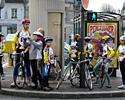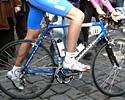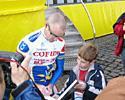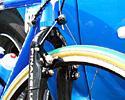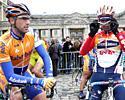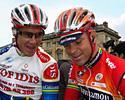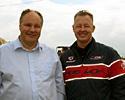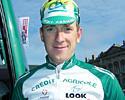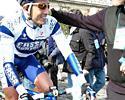
Recently on Cyclingnews.com |
Tales from the peloton, May 10, 2005
No ordinary day at the office
It's May and we're already at the Giro, but before the memories of the Spring Classics fade, Gerard Knapp takes us on a trip in the Cyclingnews 'stretch limo', bottoming out on the pavé as the crew covered Paris-Roubaix.
When interviewing riders as they prepared for Paris-Roubaix, a frequent comment was to do with luck, such as not having a puncture or crash at an inopportune time. While it is possible to complete this legendary race without one or both of the above, there are other factors at play: like bike-handling skills, teamwork and a complete lack of fear.
Vox popBefore the race, Cyclingnews spoke to several favourites and notable riders to get some impressions of what makes Roubaix so special.
Brad Wiggins Credit Agricole): "It's a very anxious race with an unknown outcome. There's no guarantees... anything can happen. Which is why it's a very memorable moment getting to Roubaix. If you do get into the velodrome, that's what makes this race so special. My riding so far has been difficult, because I have been going through hard personal times as my partner has had a difficulty pregnancy. There were several interruptions in my training. But now my first son has been born and his name is Ben. For this race, Thor [Hushovd] is in great form and so the team will look after him, staying really close to him. If he punctures, because sometimes the spares can't be replaced as fast, we will stay close and give him a wheel."
George Hincapie (Discovery): "There are some race tactics planned but it's a race of attrition. So if you have good luck and good legs, the main thing is just to save as much energy as you can for the finish. The strong guys will make the difference in the last 20-30 km. And these guys are Cancellara, Flecha, Van Petegem and Bäckstedt. We have Eki, Leif and myself, so we also have a good team."
Roger Hammond (Discovery): "Last year, the first cobbled section was really hard. The second one started to be ok, and by the third sector, the cobbles made my it go numb. I hope it will be the same this year. If I make it to the first sector, there's a good chance I'll make it to the finish."
Juan-Antonio Flecha: "[Team-mate and co-leader Fabian Cancellara] and I know each other really well. We work really well together. We both feel very strong and we know that we'll have a good race. It might be difficult because everybody will be watching us. My personal aim is definitely top three." |
Descending a twisty mountain descent at speed is one thing, but pounding across an ancient 'road' made up of unevenly-spaced blocks of stone, each about the size of a loaf of bread, covered in a mixture of mud and cow-dung, is another.
There are urban cobblestone roads, and then there are rural goat-tracks made out of stone; these are what feature heavily in Paris-Roubaix.
The start of Paris-Roubaix in the French town of Compiegne has a special buzz. To be sure, the voice of Daniel Mangeas is there, like he is at the Tour de France, booming out vital statistics on every rider invited to the podium to sign on. It is crowded, but there's no 'Village Departe' with its traveling trade-show. It's a big, brutal bike race, and almost every rider's face says 'today is special'.
At the start, Quick Step's Tom Boonen was one of the last riders to appear, and no wonder, given the attention he received. He worked his way through the funnel in the crowd, smiling, answering questions in English and Flemish. Fabian Cancellara received words of encouragement from Rolf Sorensen, Peter van Petegem, much smaller in the flesh than his photos suggest, nervously adjusted his sunglasses, while Australian riders Stuart O 'Grady, Henk Vogels, Matt Wilson and Luke Roberts - all from different teams - seemingly found each other in the crowd, and joked as they bustled their way to the start.
It's unlike the Tour de France, with its crowds, crowds and more crowds, plus the Tour is really a race between three or four riders, until the third day in the mountains, and the rest of the field have to act as support riders, or are in their own private hell on their way to Paris. Indeed, the race is usually decided with 10 days of racing remaining.
Paris-Roubaix is dangerous, it comes around once a year; it's hardly 'another day at the office'. Two nights before the race start, O'Grady said that it was unique because one of 25 riders could possibly win, as long as everything went well on the day.
In Paris-Roubaix, to finish is heroic. The riders race like there is no tomorrow, there is no 'saving' strength for the mountains. This year, out of nearly 200 hundred starters, some 80 riders made it into the velodrome within the time limit.
Road racing goes single-track
To be sure, luck does play its part (just ask Fabian Cancellara of Fassa Bortolo, who punctured twice) but a successful Paris-Roubaix also comes down to skill - such as handling a 7kg road-racing bike over horrendous tracks while riding flat-out, but never going into blind oxygen debt and losing all-important coordination. A bad crash at Paris-Roubaix can end a rider's career.
Some of the nastier sections only have a safe route less than a metre wide; usually on the 'crown', or top of the pavé, in-between the wheel-tracks. In these really dangerous sectors - as opposed to your regular, filling-loosening pavé - to ride into the 'trenches' that form in the wheel-tracks is to invite almost certain disaster, such as a puncture, buckled rim or crash. (A flat on these sections can sometimes mean minutes waiting for a spare wheel.)
In the 'trenches', the sharp edges of the cobblestones no longer lie flat; rather, they have sunk and turned up at an angle, gaping open like granite-hard jaws, wide enough to swallow a motorcycle tyre, let alone a 20mm bicycle wheel. Inside these jaws is the hard, sharp edge of another cobble, as they overlap, perpendicular to the direction of the road. If a bicycle wheel slips into one of these cracks, it then smacks against the edge of the overlapping cobble, and it's here that the pinch flats and buckles tend to happen.
Experienced riders say that riding on the crown is the safest and fastest place to be, even if it's a bumpier ride than at the edges, which may look smoother. They may be smoother, but in wet conditions they can also hide pot-holes and broken cobblestones in the puddles, while riding in the constant mud and grit does build up on the bike and slow the legs.
If a large, long, dangerous puddle does loom up, the rider on the edge has two options: plough on through (not recommended due to aforementioned obstacles) or move up onto the crown, and invariably, that is when falls happen as trying to steer and change direction - purposefully - can lead to the front wheel catching the edge of a stone, the rider attempting to correct, and down he goes.
Also, the edges of the more brutal, slower sections on pavé are usually always occupied by screaming fans, waving flags and drinking beer, so there' s not much choice other than to plough on through on the 'crown'.
Favoured by favourites
After witnessing the poorer sectors of the Paris-Roubaix cobbles, it is no wonder why some are favourite attacking points, as the 'road' is reduced to nothing more than single-track. Following a wheel closely enough to enjoy a good draft is again a dangerous pursuit, as the riders need to be able to see what they're about to encounter. Also, if the rider in front falls, then the following rider is also likely to hit the deck if he's too close.
From pavé sector 14 down to 3 (they are numbered down in Paris-Roubaix, unlike race distance, sprints or KOMs) the race really heats up, and it was here that the serious moves were made in the 2005 race.
At sector 14 with some 80km to go, the five early attackers who once had a lead of 12 minutes or more - Erwin Thijs (MrBookmaker), Stéphane Berges and Florent Brard (Agritubel), Carlos Barredo (Liberty Seguros), Arnaud Coyot (Cofidis)- still had five minutes on the main field.
But it was in this twisting 'debut' sector of Hornaing à Wandignies (one of the new sections added after the Foret d'Arenberg was taken out for 2005) that the big guns fired in the peloton. Quick Step's directeur sportif, Patrick Lefevre, pulled the trigger with 'Pippo' Pozzatto hitting the front, lifting the speed with team-mate Tom Boonen behind, followed by Lars Michaelsen (CSC), George Hincapie (Discovery) and Magnus Bäckstedt (Liguigas).
The Quick-Step-inspired surge in the 3.7km section of pavé shattered the peloton and created a gap, with Fassa Bortolo's Juan-Antonio Flecha and Fabian Cancellara and Leon Van Bon (Davitamon-Lotto) chasing, followed by Thor Hushovd (Credit Agricole) and Erik Zabel (T-Mobile).
Even though Pozzatto was dropped not long after, the damage was done. As they exited sector 11, the five early attackers were reeled in by the Boonen-Hincapie group. They had erased their five-minute lead in just 30km, but it featured four rather nasty sections of pavé.
Part two: Hammer time
Photography
For a thumbnail gallery of these images, click here
Images by Gerard Knapp/Cyclingnews.com
- The 'rest stop' has extra meaning for this club of local junior riders at the start of Paris-Roubaix in Compiegne. Their bikes were relatively humble hand-me-downs.
- Credit Agricole's Brad Wiggins at the start - relaxed and approachable as always. "It's a very anxious race with an unknown outcome. There's no guarantees... anything can happen."
- T-Mobile's Erik Zabel: "Everybody dreams about the podium," he said. "I was there once so it might not happen again. But I certainly wouldn't mind..."
- Discovery Channel's George Hincapie, at the start - "There are some race tactics planned but it's a race of attrition."
- England's road champ Roger Hammond had a plastic brace for his broken thumb before the start, but this was to be removed as it interfered with operating the gears. He pointed out that he rode this race and finished third with a damaged ankle in the previous year.
- Lampre - Caffita's Alessandro Ballan (Ita) had had a great Tour of Flanders the previous weekend, and looked relaxed before the start, but finished Paris-Roubaix over five minutes behind.
- For Cannondale owners - one view of Ballan's special for Paris-Roubaix, with 'cross-style cantilever brakes.
- And another view of this special all-carbon Cannondale.
- Stuart O'Grady's Wilier looking nice and clean before the start.
- The popular O'Grady signs an autograph prior to the start. He was "ready to give it a good go".
- Juan Antonia Flecha before the start. The Spanish classics man was in good spirits. In Fassa, he will share the lead with his teammate Fabian Cancellara, who placed fourth last year.
- A close-up of Flecha's special 'cross-style Pinarello. This bike was also used by other members of Fassa Bortolo.
- The rear stays of Flecha's Pinarello.
- The headset assembly included a custom-painted bracket that acted as a cable-guide.
- Last year's winner of Paris-Roubaix, Magnus Backstedt rolls up to the start.
- Another previous winner, Andrea Tafi, stopped to sign autographs but seemed pre-occupied. After all, it was to be his last time.
- On the other hand, the somewhat fashionably late Tom Boonen seemed relaxed, even surrounded by a multitude of photographers and journalists. He easily answered questions in English and Flemish.
- Peter Van Petegem (right) makes a last-minute adjustment to his eyewear - not that it stays in place for long on the pave.
- Australia's two best prospects in Paris-Roubaix - and former national road champions - Cofidis' Stuart O'Grady (left) and Henk Vogels (Davitamon-Lotto).
- Spotted waiting expectantly prior to the peloton's arrival onto sector 23 of the pave is Andre Boonen (left), father of Tom and top salesman for Ridley Bicycles, with Lance Donnell from Sinclair Imports, the USA distributor for Ridley Bicycles. "He knows everyone!" Donnell said of Boonen.
- This is what the crowd has been waiting for - Cofidis rider leads the charge onto sector 23, while the omnipresent overhead helicopter gives the early warning of what's to come.
- And the peloton literally rumbles through at over 50kmh. This 'smoother' section of pave meant many riders opted to ride in the drops, and despite their speed, the female spectator on the left was able to discern her favourite rider. "Go Robbie Hunter!"
- With almost 70km to go at Tilloy-les-Marchiennes the early break included (in no particular order) Erwin Thijs (MrBookmaker), Stéphane Berges and Florent Brard (Agritubel), Sebastian Lang (Gerolsteiner), Carlos Barredo (Liberty Seguros) and Arnaud Coyot (Cofidis).
- Inside the Cyclingnews humvee as it pounds through the crowds and cobbles. Progress was slow.
- Any vantage point will do - note the front-end loader parked at the end of this sector, with a dozen local kids sitting in the bucket.
- Following a CSC team car in the final 50km, only minutes ahead of the leaders. The condition of the cobbles became very poor in the final sectors. It seems the organizers like to leave the fun stuff to the end.
- And the crowds became thicker.
- One of the many heavy vehicles parked in the paddocks alongside the nastier sectors of pave, providing a good viewing platform.
- As the leaders cross the finish line for the penultimate time Flecha leads Hincapie and Boonen. They would finish in the reverse order, as Boonen used simple track-craft to get the win.
- The distant expression says it all. George Hincapie looks in the direction of the winner's enclosure, where Boonen was being mobbed.
- A pleasantly surprised Juan Antonio Flecha pushed his bike into the infield amid the throng, propped it against a fence and sat down to be cleaned up prior to the presentation. It was also an opportunity for impromptu press conference. "It was a beautiful Roubaix," he said.
- Two former winners of Paris-Roubaix - Magnus Backstedt and Andrea Tafi - just after they finished. The big Swede made the effort to reach Tafi and congratulate him. Both made huge efforts, but April 10, 2005, was not to be their day.

